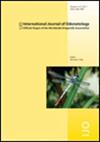Odonata drift: a reassessment
IF 1
4区 农林科学
Q3 ENTOMOLOGY
引用次数: 2
Abstract
More than 400 scientific journal articles and gray literature reports that addressed macroinvertebrate drift were reviewed and 63 articles were found that reported on the natural drift of Odonata at some taxonomic level. Forty-three species and 44 genera within 15 families (nine Zygoptera; six Anisoptera) were documented in the drift. Drift of another 13 species and eight genera was inferred from indirect evidence. The mean drift density reported was 0.03 m–3 (range <0.001–0.153 m–3), which is relatively low, but not unexpected because benthic densities of Odonata are often lower than those of the macroinvertebrate taxa that occur more frequently in the drift. Percent composition of odonates in the total drift was invariably <10% and usually <1%, but the percent was slightly higher if expressed as biomass or volume because odonate larvae are relatively large. Most odonates that drifted were not full grown. High flows were often associated with drift of Odonata, but not exclusively so; drift was highest at night and during summer months. Accidental (catastrophic) drift and active, behavioral drift to colonize new habitats and reduce crowding are thought to be the primary causes of Odonata drift, but its ecological significance would benefit from more research. The presumption that Odonata have a low predisposition to drift is probably not uniformly accurate. Use of drift nets specifically to collect odonates is unlikely to be as efficient as other collection methods in most circumstances, but it should not be entirely dismissed because drift nets are easy to set, relatively clean to operate, do not destroy habitats, and provide integrated samples of various habitats where it might be difficult or unsafe to use other methods.Odonata漂移:重新评估
综述了400余篇有关大型无脊椎动物漂移的科学期刊文章和灰色文献报告,发现了63篇在一定分类学水平上报道了蛇目动物自然漂移的文章。15科44属43种(颧翅目9目;6种异翅目)。从间接证据中推断出另外13种和8属的漂移。报告的平均漂流密度为0.03 m-3(范围< 0.001-0.153 m-3),相对较低,但并不意外,因为底栖动物的密度通常低于在漂流中更频繁出现的大型无脊椎动物类群的密度。虫卵在总漂量中的百分比组成总是<10%,通常<1%,但如果用生物量或体积来表示,百分比略高,因为虫卵幼虫相对较大。大多数漂流的海豚还没有完全长大。高流量通常与Odonata漂移有关,但并非完全如此;夜间和夏季漂流量最大。偶然的(灾难性的)漂移和主动的、行为性的漂移,以殖民新的栖息地和减少拥挤,被认为是蛙类漂移的主要原因,但其生态意义将受益于更多的研究。关于奥多纳塔有低漂移倾向的假设可能并不完全准确。在大多数情况下,专门使用流网来收集蛙类不太可能像其他收集方法那样有效,但不应完全摒弃这种方法,因为流网容易设置,操作起来相对清洁,不会破坏生境,并提供各种生境的综合样本,而使用其他方法可能很困难或不安全。
本文章由计算机程序翻译,如有差异,请以英文原文为准。
求助全文
约1分钟内获得全文
求助全文
来源期刊

International Journal of Odonatology
ENTOMOLOGY-
CiteScore
2.30
自引率
0.00%
发文量
15
审稿时长
>12 weeks
期刊介绍:
International Journal of Odonatology (IJO) is aimed at providing a publication outlet for the growing number of students of Odonata. It will address subjects such as the ecology, ethology, physiology, genetics, taxonomy, phylogeny and geographic distribution of species. Reviews will be by invitation, but authors who plan to write a review on a subject of interest to the journal are encouraged to contact the editor.
 求助内容:
求助内容: 应助结果提醒方式:
应助结果提醒方式:


